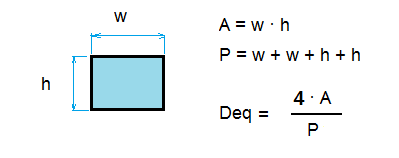The Reynolds Number (Re) is a non-dimensional parameter which indicates if a flow follows a laminar or turbulent model.
The Reynolds Number depends on the flow velocity, pipe diameter or equivalent diameter if the conduction is not circular, and the cinematic viscosity or dynamic viscosity and density.
In a circular pipe it is considered:
• Re < 2300 The flow is laminar.
• 2300 < Re < 4000 Transition zone from laminar to turbulent.
• Re > 4000 The flow is turbulent.
Hydraulic Diameter
In non-circular ducts the Reynolds Number is calculated by a Hydraulic Diameter, which can be determinated from section area (A) and the wettered perimeter (P) of the duct. In circular pipes, Hydrauclic Diameter and pipe diameter are the same.
Case: Square duct

Online calculation of the Reynolds Number
Re: Reynolds Number
d: Density ( water density = 1000kg/m³)
v: Flow Velocity
D: Pipe diameter o Hydraulic diameter
μ: Dynamic Viscosty (water dynamic viscosity = 0,001002 Pa·s)
ϑ: Cinematic viscosity (water cinematic viscosity = 1,002 cSt)
